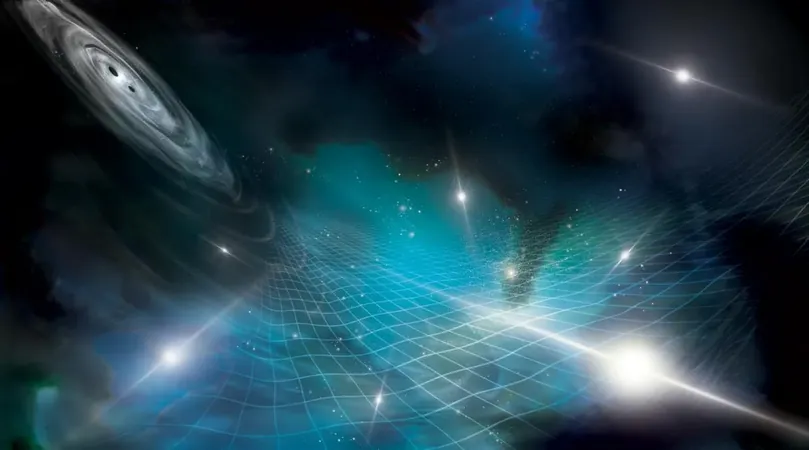
Revolutionary Theory Could Finally Unify Gravity with Quantum Physics!
2025-05-07
Author: Emma
A Game-Changer in Theoretical Physics
In a groundbreaking leap toward unraveling one of the greatest mysteries in science, researchers have introduced a novel approach that could integrate gravity with the other fundamental forces of nature. Unlike the electromagnetic, weak, and strong forces encapsulated in the Standard Model of particle physics, gravity has stubbornly eluded a quantum explanation.
Meet the Minds Behind the Breakthrough
Physicists Mikko Partanen and Jukka Tulkki from Aalto University in Finland are at the forefront of this revolution. Their recently published work suggests a fresh, gauge theory approach to describe gravity, potentially paving the way to a so-called "Theory of Everything."
Why Has Unifying Gravity Been So Challenging?
The Standard Model is grounded in quantum field theory, which fuses classical field theory, quantum mechanics, and special relativity. It deftly explains particles’ interactions through gauge fields that uphold nature's symmetries. Meanwhile, gravity operates within the realms of general relativity, viewing space-time as warped by mass and energy—a fundamentally distinct framework.
The resulting clash between the two domains has hindered efforts to amalgamate gravity with quantum mechanics, prompting the rise of several alternative theories like string theory and loop quantum gravity.
A Fresh Perspective on Gravity
Partanen and Tulkki's innovative theory employs an eight-component spinorial representation of quantum fields, known as eight-spinors. By introducing a new "space-time dimension field," they successfully extract conventional four-dimensional quantities from eight-dimensional spinor space, enabling gravity to be understood through compact, finite-dimensional unitary symmetries—akin to those present in the Standard Model.
The Symmetry That Could Change Everything
Dubbed unified gravity, this theory relies on four U(1) symmetry transformations that describe gravity as a gauge theory. This approach allows gravity to be articulated in flat space-time, utilizing the Minkowski metric, without the complex curved space-time inherent in general relativity. Partanen states, "This makes it possible to express gravity in the same mathematical framework as the other fundamental forces—an unprecedented achievement."
Introducing Feynman Rules for Unified Gravity
The researchers have also developed Feynman rules to streamline calculations of particle interactions under this new gravity framework. Their findings indicate that infinities could be absorbed into a limited number of parameters—the same way quantum electrodynamics operates!
Turning Theory into Reality
Unified gravity doesn't just represent a mathematical advancement; it also provides valuable tools to delve into the universe's most extreme scenarios, such as the interiors of black holes and the moment of the Big Bang. Partanen emphasizes that a quantum theory of gravity is essential for comprehensively understanding high-energy physics, which behaves distinctively far beyond our typical experiences.
A Potential Revolution Awaits!
Both Partanen and Tulkki see this theory as a promising avenue to answer profound cosmic questions, including the mystery of why more matter than antimatter exists in the universe. They believe that within a few years, we may gain much deeper insights into these enigma.
Bridging Diverse Theoretical Realms
Historically, gravity's interaction with quantum theory has been nebulous. However, Partanen and Tulkki categorize their new U(1) symmetries of gravity as internal symmetries, making them compatible with the Standard Model's framework—crucial for integrating gravity into modern physics.
Testing the Waters
Despite its departure from conventional thinking, unified gravity can replicate existing results, aligning with experimental observations like gravitational waves and black hole imaging. The theory isn't finalized yet; Partanen and Tulkki aim to prove its validity across all renormalizability orders. However, their enthusiasm shines through as they invite the scientific community to engage with and refine their groundbreaking ideas.
The Future of Unified Gravity
As they venture forth, the duo anticipates that unified gravity might set the stage for future advancements in physics, potentially leading to revolutionary technologies we can only dream of today. Are we on the brink of uncovering the secrets of the universe?









 Brasil (PT)
Brasil (PT)
 Canada (EN)
Canada (EN)
 Chile (ES)
Chile (ES)
 Česko (CS)
Česko (CS)
 대한민국 (KO)
대한민국 (KO)
 España (ES)
España (ES)
 France (FR)
France (FR)
 Hong Kong (EN)
Hong Kong (EN)
 Italia (IT)
Italia (IT)
 日本 (JA)
日本 (JA)
 Magyarország (HU)
Magyarország (HU)
 Norge (NO)
Norge (NO)
 Polska (PL)
Polska (PL)
 Schweiz (DE)
Schweiz (DE)
 Singapore (EN)
Singapore (EN)
 Sverige (SV)
Sverige (SV)
 Suomi (FI)
Suomi (FI)
 Türkiye (TR)
Türkiye (TR)
 الإمارات العربية المتحدة (AR)
الإمارات العربية المتحدة (AR)